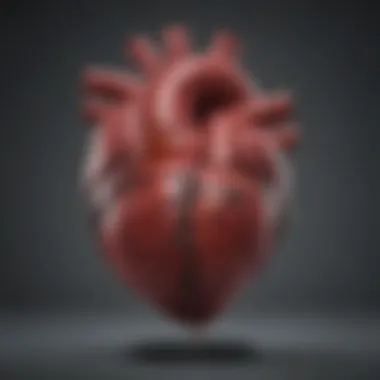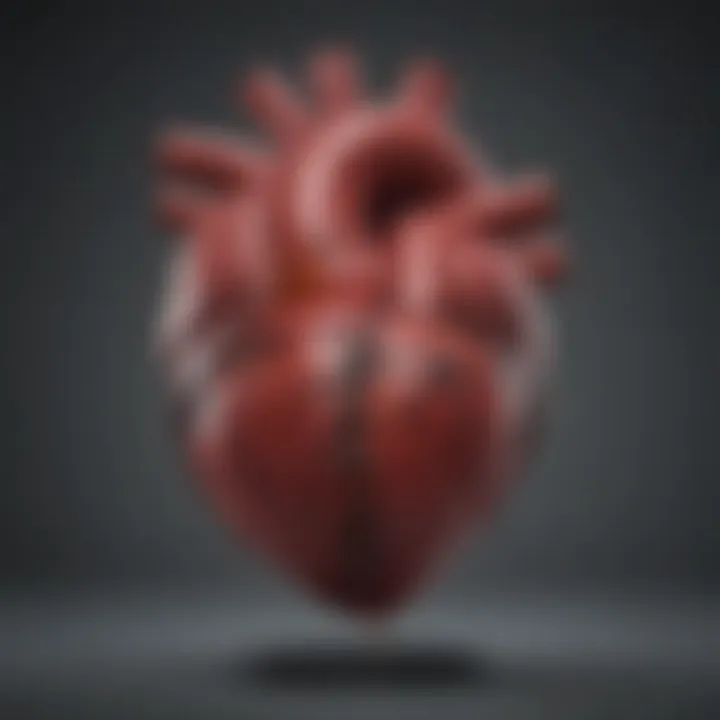Exploring the Intricacies of Physical Symptoms During a Panic Attack


Strategies for Success
Leadership Psychology Insights
Within the context of panic attacks, insights from leadership psychology can shed light on effective ways to manage and mitigate the physical manifestations of such episodes. Emotional intelligence in leadership plays a vital role in helping individuals recognize and regulate their emotions during moments of heightened anxiety, enabling them to approach panic attacks with greater self-awareness and composure. Effective communication skills are also paramount in dealing with the physical symptoms of panic attacks, as clear and assertive communication can aid in seeking support and understanding from others. Furthermore, team building strategies can create a supportive environment for individuals experiencing panic attacks, fostering collaboration and empathy among peers.
Personal Growth and Development
Exploring the physical symptoms of a panic attack can catalyze personal growth and development, leading to profound mindset shifts for success. By reframing negative thoughts and beliefs related to panic attacks, individuals can adopt a growth mindset that empowers them to face challenges with resilience and optimism. Engaging in self-care practices is essential in nurturing mental and emotional well-being, providing individuals with the tools to prioritize their health and self-awareness amidst the turmoil of panic attacks. Moreover, overcoming challenges and adversities encountered during panic attacks can cultivate a sense of strength and perseverance, fueling personal growth and resilience in the face of adversity.
Business Growth Strategies
From a business perspective, understanding the physical symptoms of panic attacks can inform strategic growth initiatives within organizations. Implementing effective marketing and branding strategies can help businesses navigate turbulent times with flexibility and resilience, creating value propositions that resonate with consumers amidst challenging circumstances. Sound financial management tips are crucial in ensuring the stability and sustainability of businesses facing disruptions caused by panic attacks, fostering financial resilience and adaptability. Embracing innovation and entrepreneurship in the face of uncertainty can propel businesses to new heights, leveraging creativity and ingenuity to thrive in unpredictable market conditions.
Case Studies and Real-Life Examples
Real-life examples and case studies offer valuable insights into how individuals and organizations have navigated and overcome the physical symptoms of panic attacks. Success stories of entrepreneurs highlight the resilience and determination required to flourish in the face of adversity, showcasing the transformative power of perseverance and innovation. Leadership lessons from industry experts underscore the importance of emotional intelligence and strategic decision-making in managing and mitigating the impacts of panic attacks in professional settings. Furthermore, business turnaround case studies provide practical illustrations of how strategic planning and resilience can facilitate the revitalization of businesses facing challenges related to panic attacks, offering inspirational narratives of triumph and growth.
Introduction to Panic Attacks
Understanding the context of panic attacks is crucial for navigating the complexities surrounding this issue. In this article, we aim to shed light on the physical symptoms that accompany panic attacks, providing a detailed and insightful perspective. By delving into these manifestations, we hope to offer a comprehensive guide that will benefit individuals dealing with panic attacks and those seeking to understand them better. Exploring the physiological responses to panic can enhance awareness and promote empathy towards individuals facing such challenges.
Defining Panic Attacks
The Basics of Panic Attacks
Delving into the fundamental aspects of panic attacks is essential in grasping the core of this phenomenon. The basics of panic attacks involve sudden and intense periods of fear or discomfort, often accompanied by various physical and cognitive manifestations. Understanding these basics lays the foundation for recognizing and addressing panic attacks effectively. This exploration aims to provide clarity on the nature of panic attacks, paving the way for informed responses to such episodes. The intricate interplay between physiological and psychological factors during panic attacks underscores the significance of unraveling these basics.
Diagnostic Criteria for Panic Attacks
Examining the diagnostic criteria for panic attacks offers a structured approach to identifying and categorizing these experiences. The criteria provide a set of guidelines for healthcare professionals to assess and diagnose panic attacks accurately. By delineating specific criteria such as the frequency and duration of symptoms, clinicians can differentiate panic attacks from other conditions. Understanding these criteria enhances diagnostic precision and enables targeted interventions for individuals experiencing panic attacks. Navigating the nuances of diagnostic criteria contributes to a more nuanced understanding of panic attacks, empowering both patients and healthcare providers.


Prevalence and Impact
Epidemiological Statistics
Exploring epidemiological statistics related to panic attacks offers insights into the prevalence and distribution of this condition. Studying statistical data can reveal trends in the occurrence of panic attacks across different demographics and geographical regions. By examining epidemiological patterns, researchers can identify risk factors and potential avenues for intervention. The analysis of epidemiological statistics provides a broader context for understanding the scope and impact of panic attacks on a population level, guiding public health strategies and resource allocation.
Effects on Daily Functioning
Assessing the effects of panic attacks on daily functioning uncovers the profound impact of this condition on individuals' lives. From disruptions in work and social interactions to challenges in everyday tasks, the repercussions of panic attacks reverberate across various domains. By elucidating these effects, we aim to highlight the importance of addressing not just the symptoms but also the functional implications of panic attacks. Understanding how panic attacks affect daily functioning illuminates the urgency of tailored interventions and support mechanisms for individuals navigating these challenges.
Physical Sensations During Panic Attacks
The discussion on Physical Sensations During Panic Attacks within this article is pivotal as it unveils the intricate bodily responses triggered during a panic attack. By dissecting the cardiovascular, respiratory, gastrointestinal, neurological, musculoskeletal, and other physical manifestations, this section aims to provide a nuanced understanding of the diverse symptoms that individuals may experience amidst heightened anxiety.
Cardiovascular Symptoms
Heart Palpitations
Heart palpitations, a notable cardiac symptom during a panic attack, play a significant role in the overall manifestation of anxiety-related physical sensations. The irregular heartbeat rhythm characteristic of heart palpitations serves as a hallmark indicator of heightened stress levels, contributing to the comprehensive depiction of panic attack experiences. This symptom's distinctiveness lies in its direct correlation with the autonomic nervous system's response to perceived threats. Exploring heart palpitations enriches this article's content by shedding light on a common yet impactful physiological response during panic episodes.
Chest Pain
Incorporating chest pain into the discourse surrounding panic-induced physical symptoms adds depth and specificity to the overarching theme. The gripping, often stabbing sensation associated with chest pain denotes a critical aspect of panic attacks that profoundly influences individuals undergoing such distress. Its inclusion in this article serves to underscore the significance of thoracic discomfort in elucidating the multifaceted nature of panic attack experiences. Contrasting with other symptoms, chest pain's unique feature lies in its potential to mimic severe cardiac conditions, emphasizing the urgency of discerning panic-related symptoms from genuine medical emergencies.
Respiratory Symptoms
Shortness of Breath
Shortness of breath emerges as a pivotal respiratory symptom in the panorama of panic attacks, offering crucial insights into the interplay between emotional distress and physiological responses. The constriction of airways accompanying this symptom serves as a hallmark characteristic, shaping individuals' perception of imminent danger during anxiety-driven episodes. Delving into the intricacies of shortness of breath enriches this article by illuminating the intricate web of connections between psychological triggers and respiratory manifestations in panic situations.
Hyperventilation
The discourse on hyperventilation introduces a critical dimension to the exploration of respiratory symptoms during panic attacks. The rapid, shallow breathing patterns typifying hyperventilation play a central role in exacerbating panic-related sensations, amplifying individuals' sense of alarm and vulnerability. By delineating the unique features of hyperventilation and its immediate repercussions on overall well-being, this section enhances readers' comprehension of the intricate physiological derangements characterizing panic episodes.


Gastrointestinal Symptoms
Nausea
Nausea's inclusion in the discussion of panic-induced physical manifestations expands the narrative scope to encompass digestive irregularities as integral components of anxiety experiences. The queasy, often unsettling sensation linked to nausea signifies a profound interplay between emotional turmoil and bodily distress, encapsulating the holistic impact of panic attacks on individuals. Unpacking the key attributes of nausea adds depth to this article by elucidating the intricate relationship between psychological stressors and gastrointestinal responses in anxiety-provoked scenarios.
Stomach Upset
Stomach upset's role in shaping the physical symptoms of panic attacks underscores the substantial influence of emotional upheaval on gastrointestinal functioning. The cramping, churning sensations indicative of stomach upset amplify individuals' discomfort during panic episodes, underscoring the pervasive effects of anxiety on the digestive tract. Exploring the nuances of stomach upset within this article enriches readers' understanding of the interconnected nature of mental distress and somatic reactions, fostering a comprehensive grasp of panic-induced physiological manifestations.
Neurological Symptoms
Dizziness
The exploration of dizziness as a prominent neurological symptom in panic situations illuminates the intricate cognitive and perceptual alterations that accompany heightened anxiety states. The lightheadedness and unsteadiness characterizing dizziness offer a unique vantage point into the disruptive effects of panic attacks on individuals' sensorimotor integration and equilibrium. By delineating the specific features of dizziness and its multifaceted impact on cognitive processes, this section enhances the reader's awareness of the intricate neurological manifestations intertwined with panic-induced physical sensations.
Numbness or Tingling
The inclusion of numbness or tingling sensations in the discussion of panic-related neurological symptoms enriches the narrative landscape by exposing readers to the intricacies of somatosensory disruptions during heightened stress responses. The tingling, prickling sensations and transient numbness hallmarking this symptom provide valuable insights into the intricate interplay between emotional arousal and sensory perceptions during panic episodes. Unpacking the unique characteristics of numbness or tingling within this article offers readers a comprehensive understanding of the diverse neurological manifestations that can accompany anxiety-driven physiological responses.
Musculoskeletal Symptoms
Trembling or Shaking
Trembling or shaking, as fundamental musculoskeletal symptoms during panic attacks, symbolize the profound impact of heightened stress on individuals' motor functions. The involuntary muscle contractions and tremors typifying this symptom underscore the intricate link between emotional distress and physical manifestations, elucidating the somatic repercussions of anxiety-provoked states. By exploring the distinct features of trembling or shaking and its implications for individuals navigating panic-induced scenarios, this segment deepens readers' appreciation of the intricate musculoskeletal responses engendered by acute anxiety.
Muscle Tension
Muscle tension's exploration in the context of panic-related physical sensations enriches the narrative by emphasizing the pervasive influence of emotional stressors on individuals' muscular systems. The tautness, stiffness, and discomfort indicative of muscle tension offer critical insights into the somatic distortions accompanying heightened anxiety levels, spotlighting the holistic impact of panic attacks on individuals' physical well-being. Deconstructing the key characteristics of muscle tension within this article fosters a nuanced understanding of the complex musculoskeletal manifestations intertwined with panic-driven physiological responses.
Other Physical Manifestations
Hot Flashes


The discussion on hot flashes as a noteworthy physical manifestation during panic episodes broadens the narrative canvas to encompass thermoregulatory disturbances as integral components of anxiety-induced physiological responses. The sudden waves of heat and perspiration characteristic of hot flashes illuminate the profound intersection between emotional distress and autonomic dysregulation, encapsulating the nuanced interplay between psychological triggers and thermal discomfort in panicked states. By delineating the unique attributes of hot flashes and their implications for individuals grappling with panic-induced sensations, this section deepens readers' understanding of the diverse bodily manifestations intertwined with anxiety-driven responses.
Chills
Incorporating chills into the discourse on panic-induced physical symptoms adds granularity to the portrayal of autonomic fluctuations accompanying anxiety-provoked episodes. The shivering, goosebumps, and chilling sensations emblematic of chills underscore the complex interplay between emotional arousal and thermoregulatory adjustments, highlighting the intricate balance between psychological agitation and physical reactions in panic situations. Unveiling the specifics of chills within this article offers readers a comprehensive insight into the diverse physiological responses elicited by acute anxiety, enhancing their awareness of the multifaceted nature of panic-induced physical manifestations.
Psychological Impact of Physical Symptoms
In delving into the intricacies of panic attacks, it is imperative to understand the profound psychological impact of the physical symptoms experienced during these episodes. This article aims to shed light on how these symptoms can significantly influence an individual's mental state, exacerbating feelings of fear and distress. By elucidating the connection between the body's reactions and the mind's response, a holistic understanding of panic attacks emerges. Recognizing and addressing the psychological repercussions of these symptoms is crucial in effectively managing and coping with panic attacks.
Understanding the Mind-Body Connection
Impact of Physical Symptoms on Anxiety Levels
The impact of physical symptoms on anxiety levels plays a pivotal role in the manifestation and escalation of panic attacks. When individuals experience physiological sensations such as palpitations or shortness of breath, these symptoms can trigger heightened anxiety responses. This intensification of anxiety further fuels the panic attack, creating a cyclical pattern of heightened physiological and psychological distress. Understanding this connection is crucial for developing personalized interventions that target both the physical and emotional aspects of panic attacks.
Feedback Loop of Panic Reactions
The feedback loop of panic reactions elucidates how physical symptoms can trigger cognitive and emotional responses that perpetuate the cycle of panic. When an individual experiences symptoms like dizziness or trembling, their cognitive interpretation of these sensations can exacerbate feelings of panic and fear. This feedback loop reinforces the individual's perception of threat, sustaining the intensity of the panic attack. By disrupting this loop through targeted interventions, individuals can learn to reframe their interpretations of physical sensations, thereby mitigating the impact of panic reactions.
Coping Strategies and Management
Breathing Exercises
Breathing exercises serve as invaluable tools in managing the physical symptoms of panic attacks. By focusing on deep, diaphragmatic breathing, individuals can regulate their physiological responses and induce a sense of calmness. The key characteristic of breathing exercises lies in their immediate impact on reducing hyperventilation and lowering heart rate, counteracting the escalation of panic symptoms. Incorporating breathing exercises into one's coping strategy empowers individuals to regain control over their breathing patterns and diminish the intensity of panic episodes.
Mindfulness Techniques
Mindfulness techniques offer a holistic approach to managing panic attacks by cultivating present-moment awareness and acceptance of one's experiences. The key characteristic of mindfulness lies in its ability to ground individuals in the current reality, detaching them from catastrophic thoughts associated with panic attacks. By practicing mindfulness, individuals can observe their physical symptoms without judgment, fostering a sense of detachment and tranquility. This unique feature of mindfulness enhances self-awareness and emotional regulation, equipping individuals with valuable skills to navigate the challenges of panic attacks.
Conclusion: The Essential Closure
As we conclude this insightful journey into the labyrinth of physical symptoms during a panic attack, it is imperative to reflect on the significance of comprehension and management. The enigmatic nature of panic attacks often leaves individuals bewildered and in a state of disarray. Through meticulous examination of the cardiovascular, respiratory, gastrointestinal, neurological, and musculoskeletal manifestations coupled with other physical conundrums such as hot flashes and chills, a holistic panorama unfolds before our eyes.
This detailed exploration not only enhances our awareness but also serves as a beacon of knowledge for those navigating through the complexities of panic attacks. By unraveling the intricate web of sensations and responses, we equip ourselves with the tools necessary to confront and mitigate the harrowing impact of panic attacks. Understanding the nuanced interplay between the mind and body is paramount in fostering an environment of control and resilience.
Moreover, the elucidation of coping strategies like breathing exercises and mindfulness techniques offers a ray of hope amidst the turbulent storm of anxiety. It underscores the proactive approach one can adopt to regain a semblance of equilibrium during overwhelming moments. This comprehensive guide encapsulates the essence of empowerment and education, providing a lifeline for individuals grappling with the tumultuous waves of panic.
In essence, this conclusive segment serves as a testament to the transformative power of knowledge and understanding. It underscores the pivotal role of information in demystifying the enigmas of panic attacks and empowers individuals to confront these challenges head-on. Through a blend of introspection, education, and resilience, one can pave the way towards a brighter and more controlled future in the face of adversity.



